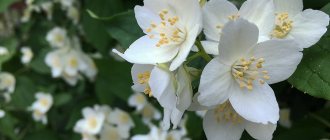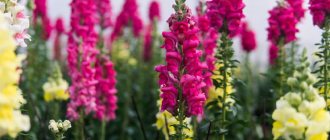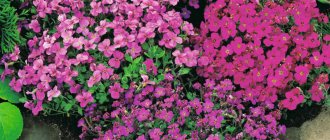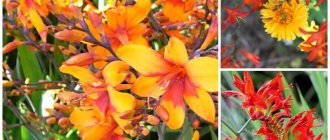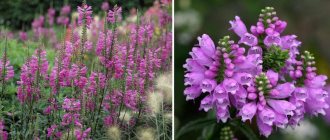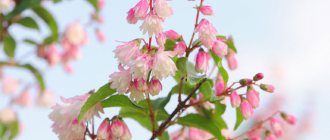The herbaceous perennial plant Kniphofia, also called Kniphofia, is a representative of the subfamily Asphodelaceae of the Xanthorrheaceae family. In nature, this plant grows in Eastern and Southern Africa, and it can be found at an altitude of up to 4 thousand meters above sea level. Previously, this genus was a representative of the Liliaceae family. It unites 75 species, some of which, as well as Kniphofia hybrids, are cultivated as beautiful flowering plants. This genus was named after the German botanist Johann Hieronymus Kniephof.
1.Description - what the flower looks like
The genus Kniphofia, Tritoma or Kniphofia includes perennial flowering plants with numerous, bright green leaves collected in basal rosettes. The rhizomes are short and thick.
The leaf blades are glossy, linear, entire or covered with very fine teeth, slightly bent along the central vein. The leaves can reach 90 cm in length.
In late spring - early summer, the bushes throw out several vertical flower stalks with multi-flowered inflorescences at the top. The inflorescences are spike-shaped, 10–20 cm long, and consist of several dozen tubular flowers. The surface of the buds is covered with sparse pubescence.
Gradually opening, the flowers often change their color from rich red to light yellow, due to which the inflorescences are often colored in several shades at once. In appearance, the inflorescences resemble burning torches, which is why European flower growers gave the plant another name - “torch lily.”
After flowering, achenes are formed - capsules containing small, black seeds. Among the 75 species included in this genus, both evergreen and deciduous plants are found.
The plant received its name in honor of Johann Hieronymus Kniephof (1704-1763), a German physician and botanist.
↑ Up,
Height . Depending on the type, plant height can range from 25 cm to 2 meters.
Features of Knifofia
The flowering plant Kniphofia is an exotic perennial that can be evergreen. The height of the bushes varies from 0.6 to 1.5 m. At the same time, the Thomson kniphofia species can have a height of about 300 cm. The short rhizome is quite thick. The basal rosette consists of leathery, sword-shaped leaf plates. From the middle of this rosette grow leafless peduncles that bear plump or spike-shaped apical inflorescences. The inflorescences include drooping small flowers of red, yellow or coral color. This culture has one distinctive feature, namely: the buds (most often red) and flowers (most often yellow) on one bush are painted in different colors. Kniphofia blooms in mid-summer, and the faded bush does not lose its spectacular appearance until late autumn. The fruit is a capsule.
Kniphofia perennial. I advise you to plant kniphofia!
2.When does kniphofia bloom?
The flowering period begins in May - June and lasts a very long time. Tubular buds, opening sequentially - from the base of the inflorescences to their tops, prolong the flowering time.
Some varieties are able to bloom in August and September. With timely pruning of flower stalks with wilted buds in the summer months, re-blooming in the fall is possible, although it will be less abundant. Often such flowering is interrupted by frost.
↑ Up,
Trimming
One of the main agrotechnical measures in growing kniphofia, a photo of which is given in the material, is proper pruning. It should be done in the spring, as soon as the fabric that covered the flower for the winter is removed. You should carefully inspect the bush and remove all frostbitten and yellowed parts. In addition to this procedure, immediately after flowering, you need to remove the flower stalks at the root, since collecting seeds from them is useless. After all, all types of kniphofia that can grow in Russia are hybrids, and therefore simply cannot bear maternal characteristics. So such attempts to divorce her will remain fruitless.
Varieties and types:
3.1. Kniphofia berry - Kniphofia uvaria
A fast-growing evergreen perennial up to 150 - 180 cm high with large inflorescences that change shade from pink to yellow as they bloom. The flowering period for this species begins in May - June and lasts until the first frost. Plants of this type will feel best in the southern regions.
↑ Up,
3.2. Hybrid Kniphofia - Kniphofia x hybrida
Plants are called hybrid. obtained from crossing different species. Positive features of such specimens include increased resistance to frost, long-lasting and abundant flowering. Hybrids are bred to improve the characteristics of species plants. The disadvantage of such plants is that when grown from seeds, most daughter bushes will not inherit the varietal characteristics of their parents.
↑ Up,
3.3. Kniphofia Flamenco - Kniphofia flamenco
Plants of this variety reach a height of 60 to 90 cm and are characterized by very long flowering. The flowering period begins in the first half of June and often lasts throughout the summer.
↑ Up,
3.4. Kniphofia Alcazar - Kniphofia alcazar
The shoots of this flowering perennial reach a height of 60 - 80 cm and bear at the tops large, oblong inflorescences consisting of orange, delicate buds. The first buds form already in May.
↑ Up,
3.5. Kniphofia Tucka - Kniphofia tuckii
This species is characterized by high frost resistance; these plants are easily grown in the conditions of the Middle Zone. The height of these perennials is usually 70 - 90 cm. Numerous candle-shaped inflorescences of plants are formed in May - June. Perhaps this is the only species that can be left for the winter in the open ground, provided there is good shelter.
↑ Up,
3.6.Kniphofia Flaming Torch
Plants of this variety reach a height of 120 - 150 cm; during the flowering period they decorate themselves with large multi-flowered inflorescences, consisting of several dozen drooping tubular flowers. The color of the inflorescences changes as they bloom from light green to burgundy. Flowering occurs in late spring.
↑ Up,
3.7.Kniphofia Ice Queen
A characteristic feature of this variety is the presence of light inflorescences consisting of greenish or lemon-yellow flowers. As they fade, the lower buds turn white. The bushes reach a height of 120 cm, the flowering period begins in the first half of June.
↑ Up,
Growing from seeds to seedlings
In the second decade of March or early April, it is time to sow planting material. The seeds must have a suitable shelf life. For hybrid varieties, it is advisable to buy planting material from a trusted agricultural store to avoid planting expired elements.
Soil and container
To germinate seeds, you need a wide and not very deep wooden box or container. I put drainage at the bottom, for example, expanded clay or pebbles, then pour in a nutritious, but always light, substrate containing humus, peat, sand.
Planting material is not buried in the soil, but simply placed on the surface of the substrate. Next, the seeds are lightly sprinkled with slightly moistened soil, water is sprayed from a spray bottle, and the container is covered with thick film or glass to maintain the “high humidity” mode. In such conditions, an optimal microclimate is created for the germination of African plant seeds.
To speed up germination, it is useful to treat the planting material with Fitosporin or Kornevin. The working solution is prepared according to the recommendations on the package. It is important to adhere to the timing of soaking the seeds so as not to harm the planting material.
Temperature and lighting
While the “black earth” period lasts, the mini-greenhouse should be covered with glass.
It is important that the container is located in an area with good lighting, not in a draft. Suitable room temperature is about +22 degrees. You can place the container on the windowsill, but you need to make sure that the sun in the southern regions does not fall on the ground all day. On a note! A couple of times during the germination period you need to remove the glass or film, wash off the condensation, and spray the substrate if necessary. To prevent mold from appearing, before placing it in a container, the soil is watered with potassium permanganate (always a strong solution) or calcined in the oven.
Seedling care
After germination, it is important to follow the rules:
- Water the seedlings as needed, making sure that the substrate is not dry. You should not overwater the young shoots of Kniphofia: the African plant does not tolerate waterlogged soil, rotting begins, and the “black leg” disease develops. Moderate watering is carried out along the edge of the container and under each seedling, making sure that the moisture does not remain on the leaves for a long time;
- seedlings are germinated in a lighted place. The same rule applies as when growing other species: seedlings should not be kept in a cold, dark or shaded place. In low light conditions, the sprouts stretch out, weaken, become fragile, and get sick;
- Kniphofia seedlings after emergence are grown at a temperature of about +18..+20°C. Too high rates interfere with the gradual strengthening of seedlings; the sprouts quickly stretch out and are ready for transplanting into open ground earlier than weather conditions allow. Overstayed, elongated seedlings are always more frail than seedlings grown in compliance with the deadlines and rules.
Transplanting
The picking is carried out when three true leaves are thrown out. It is important that before planting sprouts in open ground, the seedlings are accustomed to the action of fresh air. First, open the film for half an hour, then for a longer period. Before planting, the seedlings spend the night outside if the air is well warmed up and the temperature does not drop below +14 degrees.
The complete absence of return frosts, good heating of the soil is a prerequisite for moving seedlings into the soil without fear for the further condition of the “African beauty” Kniphofia.
Holes are dug in the soil depending on the size of the plant. At the bottom of the recess you need a layer of sand or expanded clay: this way it is easier to ensure a good outflow of water and prevent rotting of the roots. A mixture of three components (humus, peat and sand) is poured over the drainage, then strengthened and hardened seedlings are planted.
4.Planting and care in open ground
Since Kniphofia grows in hot and dry areas, it should be given a sunny and warm location in the garden.
An excellent solution would be to place plants on the south side of buildings and structures. Heating up during the daytime, the walls of buildings will give off additional heat to the flower at night. Make sure that moisture from the roof does not reach the ground in this area.
To obtain additional heat, you can use large stones - during the day they will accumulate solar heat, and at night they will gradually release it to the flowers. Direct sunlight should hit the bushes for most of the day.
↑ Up,
Plants prefer a slight drought rather than constantly moist soil, so planting should be done in light soils with a high content of river sand.
Flooded areas and dense clay soils that hardly allow moisture to pass through after watering or rain are not suitable for planting. The plant loves nutritious soils with a high content of well-rotted organic matter - peat, animal manure or humus.
↑ Up,
4.1.How and when to plant
Seedlings are planted in the garden only in the second half of June - early July, when the weather is consistently warm. In a cool and humid atmosphere, plants die easily.
The seedlings are first hardened off for 7-10 days, acclimating them to new living conditions. To harden, flower pots are taken outside and left there for 2 - 3 hours. Gradually, the time of such hardening is increased.
For young plants, it is worth choosing a semi-shaded location, and in the second or third year, move them to a brightly sunny place.
↑ Up,
To grow a flower, prepare a plot of land - dig it with a shovel and weed it out of weeds. The soil is mixed with river sand and food is added - rotted organic matter, wood ash or mineral fertilizers for flower crops.
For planting, planting holes are made, the distance between which will depend on the size of the plants and the planting pattern. As a rule, about 30 - 40 cm of free space is left between low-growing varieties, while for tall varieties and species it is worth leaving a distance between holes of 60 - 80 cm.
The depth and width of the holes should slightly exceed the size of the root system. It is advisable to place a drainage layer in the form of river sand at the bottom of the holes - it will prevent the occurrence of root rot due to stagnant moisture.
↑ Up,
The day before planting, water the plants abundantly, allowing the substrate in the pot to become soft. Seedlings are planted using transshipment, keeping the root ball intact. Make sure that the crown of the plants remains level with the ground.
The planted bushes are watered, and the soil around them is lightly compacted to remove air pockets. After planting, you can put a small layer of mulch on the site, consisting of sawdust, small pieces of bark or straw. Mulch should not prevent air from penetrating into the soil - the plant’s root system should breathe.
↑ Up,
When planted with rhizomes, during the first 2 - 3 weeks the plants often show no signs of growth - at this time the root system is actively growing under the soil surface. Only when the plants are well rooted does the formation of the above-ground green part begin.
In the first year, kniphofia usually grows leaves and roots; the first buds will decorate the bushes only in the second year after planting.
↑ Up,
4.2.How to care
Plants grown in the garden will need timely watering, fertilizing, loosening the soil and weeding. Periodically, to maintain an attractive appearance, the flower stalks with withered buds are cut off with sharp pruning shears. This pruning stimulates plants to form new inflorescences.
Sanitary pruning is carried out in the spring - leaves damaged in winter and old, dying leaf blades are cut off.
↑ Up,
Water the flower only when the soil dries out, if the weather has been dry and hot for a long period of time. Watering is carried out with warm water in the morning or evening. Watering during the day is not advisable - moisture evaporates too quickly from the surface of the soil, without having time to penetrate into the depths.
When watering, make sure that moisture does not get into the axils of the leaves and onto the flowers and buds. After watering, the soil is usually loosened and the area is weeded to remove weeds.
Tall varieties and types of flowers will need support - gusts of wind can easily break the flower stalks.
↑ Up,
4.3.Fertilizer
Kniphofia responds well to both mineral compounds and organic matter. They add food only 2-3 times per season. The first fertilizing with nitrogen mineral fertilizers is carried out with the appearance of the first leaves - such compositions will help plants quickly form green mass.
As soon as flower stalks appear, you can add potassium and phosphorus compounds for flowering plants. After flowering, potassium fertilizers are applied to strengthen the root system - for example, wood ash is added.
↑ Up,
4.4. Shelter for the winter
In order for the wintering of kniphofia to be successful, the plants should be properly prepared for it. In the autumn months, when the air temperature at night often drops below zero, the long leaves of the flower are tied into a bundle and laid on the ground. You can also braid the leaves instead of tying them. Peduncles are cut at the base with a sharp sterile pruner.
For insulation, the bushes are sprinkled with a layer of humus or peat. Dry fallen leaves or spruce branches are placed on the mulch. In order to protect the plants from excess moisture, an additional plastic film or piece of slate is placed over the spruce branches.
↑ Up,
The shelter is removed when the snow melts and the top layer of soil warms up sufficiently. Unfortunately, plants do not always survive winter; most often the cause of death is a large amount of melt water or untimely removal of the cover, as a result of which the flower simply withers away.
Not all species have good frost resistance - Kniphofia Tukka feels best in the conditions of the Middle Zone.
↑ Up,
4.5.When to dig
In order to preserve kniphofia rhizomes for a long time, they should be dug up and placed in a cool and dry place for the winter - for example, in a cellar.
Plants are dug up in the second half of October or early November, when frosts often occur at night. The bushes are taken out of the ground and shaken off any remaining soil.
The roots are carefully examined and if there are rotten or dead sections, all diseased parts are cut off to healthy tissue. Leaf blades should not be trimmed.
↑ Up,
4.6.Storage in winter
To ensure that the rhizomes do not lose their life-giving moisture during storage, they are buried in the ground in large flower pots. During the winter, plants are stored in the basement, keeping the soil barely moist.
The air temperature in the room should be 5 - 8 degrees Celsius. Planting in the garden is carried out in late May - early June.
↑ Up,
Features of growing ornamental crops
The origin of the plant dictates its own laws - for a favorable growing season and confident flowering, most varieties require a hot climate with sunny weather and short, mild winters. In the northern regions and central part of Russia, only one variety of perennial is more often planted - Kniphofia Tukka.
It is better to grow exotic flowers in areas where the sun reigns most of the day - elevated areas, southern slopes. To make the plant bloom longer, only light partial shade is allowed. When determining the planting site, drafts should be excluded.
It is best to plant kniphofia in places open to sunlight and near water bodies.
Due to the fact that kniphofia is a rather tall plant, it is better to use it in the middle of flower arrangements. And the brightness of the coloring of this African exotic recommends a competent approach to the formation of a flower bed - next to the perennial it is better to place squat representatives of the flora with discreet flowers and an abundance of greenery.
Under natural growing conditions, kniphofia happily settles in places with high humidity - near swamps and ponds . In landscape design, you can use this natural “love” for water and plant a flower next to artificial ponds in your garden plot.
5.Reproduction
Two methods are suitable for propagating kniphofia: growing from seeds and dividing rhizomes.
5.1.Growing from seeds
In the southern regions you can get seeds from your own plants. To do this, in the summer months, during flowering, the largest and most brightly colored inflorescences are marked and marked by tying them with colored thread. After flowering, wait for the seeds to fully ripen.
The seeds are removed from the boxes and sent to dry in a warm and well-ventilated room for 2 - 3 days. Planting material prepared in this way does not lose its viability for 2 - 3 years if stored in a cool and dry place in paper bags.
↑ Up,
When propagated by seed, varietal plants may lose their attractive appearance. In the conditions of the Middle Zone, seeds rarely ripen completely.
Plants are sown using seeds at home to obtain seedlings. Sowing of seeds is carried out in the second half of March or early April. Beforehand, you can keep the seeds in warm water with the addition of growth-stimulating drugs for half an hour.
↑ Up,
Prepare seedling boxes with transparent plastic lids for planting. There should be drainage holes large enough at the bottom of the containers to allow water to drain out.
Expanded clay or small pieces of foam are laid as the first layer. Fill the box with a nutritious flower soil mixture and thoroughly moisten its surface with warm water using a spray bottle. Peat mixed in equal quantities with river sand is suitable for planting.
↑ Up,
5.1.1.Sowing
Seeds are laid out on the surface of the soil and covered with a layer of soil about 3 - 5 mm thick. The boxes are covered with lids and left in a well-lit place without direct sun access. The room temperature should be between 18 and 24 degrees Celsius.
Every day the cover is removed, the crops are ventilated and any water condensation that appears is wiped off. If you follow this agricultural technology, the first shoots may appear within 2 - 3 weeks. When the sprouts appear, the cover is removed.
↑ Up,
5.1.2.Caring for seedlings
Keep plants in a warm room, keeping the soil evenly moist, but not waterlogged. When each bush has 2 true leaves, a dive is carried out.
For seating, prepare small cups with drainage holes and a moisture-wicking layer. Fill the boxes with the same soil in which the seeds were sown.
↑ Up,
The plants are carefully lifted and transferred along with the root ball, being careful not to destroy it. After diving, watering is carried out. After 10 days, when the plants have become sufficiently accustomed to the new place, the first feeding is carried out.
Nitrogen-containing compounds are used as the first fertilizers, diluting them to a quarter of the dose recommended on the package. The plants are grown until early July and planted in the garden. The first buds will decorate such specimens at the age of 2 - 3 years.
↑ Up,
5.2.Transplantation and division
Every 3 - 5 years, adult bushes can be divided into parts; division is carried out in the first half of May. You can determine whether the bush can be divided by the appearance of small daughter leaf rosettes in the leaf axils.
Plants are dug out of the ground and cleared of soil residues. The root system is pruned, removing diseased and dead root shoots. Plants are divided into parts by hand or using pruners.
The wound surface resulting from such division is sprinkled with crushed charcoal powder for drying and disinfection. The bushes can be left in the fresh air for 3 - 4 hours to dry the wounds.
↑ Up,
The delenki are planted in a permanent place, protected from direct sun for a week. For another 2 - 3 weeks, make sure that the soil does not dry out.
Division is quite difficult and sometimes all parts of the kniphofia die. The first flowering occurs in such plants in the second year after division.
Division helps to rejuvenate the bushes, this is especially important in regions with severe frosts - adult plants tolerate winter worse than young ones.
↑ Up,
Pests and diseases of kniphofia
Flowers growing in the garden can suffer from root rot. The factor that provokes its appearance is excess moisture and increased soil density.
If signs of this disease occur, it is necessary to remove the damaged parts of the plant. To do this, it will have to be dug up and treated with aseptic means. Afterwards the bush needs to be transplanted to another area.
Possible pest attack. Among them are spider mites and thrips. To eliminate lesions, kniphofia is treated with insecticides. To prevent infection, green manure and fragrant herbs are planted. If the gardener follows all the rules and regulations of care, the risk of developing flower diseases is minimal.
6.Use in landscape design
Depending on the size, tritoma can be grown both as a bright accent in the center of a flower garden (tall species), and as a border plant, serving as an edging of the borders of flower beds and garden paths.
Kniphofia can not only decorate the garden, but also does not lose its attractiveness for a long time when cut. Trim flower stalks early in the morning or evening using a garden knife.
↑ Up,
General description with photo
Initially, the Kniphofia genus was assigned to the Liliaceae family, however, after a refined systematization, it was assigned to the Xantorreidae family. It is an evergreen decoratively flowering perennial with a dense basal rosette formed by dense narrow arrow-shaped leaves. In mid-summer, a tall bare peduncle shoots out from the center of this rosette, at the top of which a plume-shaped or racemose dense inflorescence of the original type is formed.
The flowering itself is interesting and unusual. The buds that look like small bells in different varieties can begin to bloom both from the bottom of the inflorescence up and from the top down. As they open, they can change their color several times in the palette characteristic of this species. For example, from red to orange, then to bright yellow and finally becoming light lemon. Moreover, as flowering progresses, this metamorphosis in individual specimens can occur several times.
The plant can also be found under other names: tritoma, kniphophia or notosceptrum.
Some types of kniphofia can grow on the highest mountain peaks - up to 4 km above sea level!
7.Home care
Rhizomes can be planted in pots in the spring. Make sure there are drainage holes in the bottom of the containers and place a drainage layer on the bottom of the pot. Fill the pot up to half the volume with a nutrient substrate consisting of ready-made flower mixtures.
Your own soil mixture can be made from garden soil with the addition of leaf and turf humus, peat and well-rotted manure.
Place the rhizomes on the ground and add soil so that the surface of the soil after compaction is 1 - 2 cm below the walls of the pot. Water the plants and leave them in a warm place with good lighting.
↑ Up,
For a permanent location, it is worth choosing brightly lit south-eastern or south-western window sills. Water the flower carefully after planting, gradually increasing the amount of moisture as the leaf plates develop. After flowering, the frequency of watering is also reduced.
Since the flower in a flower pot has a limited feeding area, for abundant and long-lasting flowering, mineral fertilizers with a high content of potassium and phosphorus are applied 2 times a month. Fertilizing is carried out after heavy watering, adding fertilizers to the moist soil. In the fall, feeding is stopped and the plants are sent to rest.
↑ Up,
During the dormant period, it is worth taking the flower to a dark, cool place, reducing watering to a minimum, simply protecting the soil in the pot from drying out completely.
If the plants begin to show signs of new growth, they are again taken out to a well-lit place, replanted in fresh soil and begin to gradually water and feed.
For growing at home, it is better to choose compact varieties of kniphofia.
↑ Up,
Watering and fertilizing
Kniphofia is a perennial that responds well to drought. It is worth watering the plant rarely enough to prevent possible stagnation of moisture, which is more dangerous for the crop. However, if you make a good drainage system when planting, then preventing this will be quite simple.
Particular attention should also be paid to feeding. In the spring, when the first leaves just appear, you need to fertilize it with nitrogen fertilizers, and then after some time feed it with organic matter, that is, humus, peat or compost. As soon as the plant stops blooming, it is advisable to fertilize it with fertilizers containing ash and potassium. They are not only nutritious, but also provide the necessary substances that will help the plant survive the winter.
Possible problems in growing kniphofia
If you properly care for the plant, it will not be susceptible to disease. Errors in care make Kniphofia susceptible to many diseases. Thus, excessive systematic watering can lead to the formation of root rot. If at the initial stage it is possible to use fungicides, then in a neglected state the only way out will be to remove the plant from the garden.
Root rot as a common disease of kniphophia
As for insect pests, kniphofia can be attacked by:
- spider mite;
- aphid;
- thrips and other leaf-eating and sucking insects.
The Kniphofia flower is a desirable plant for many gardeners. With proper care, it grows into a real garden decoration and becomes part of modern landscape design.
The history of the appearance of the kniphofia flower
Kniphofia is a perennial flower belonging to the little-known Asphodelaceae family. In nature, it grows in warm African countries, as well as in Madagascar. The flower was first discovered and described in the 18th century by a German botanist named Johann Kniephof (1704-1763). It was in his honor that the plant got its name.
Also called:
- kniphophia;
- tritome.
The flower was cultivated quite quickly - already in the 18th century, kniphofia began to appear in the gardens of Europe. Gradually, it spread widely in neighboring countries, including Russia, Turkey, the USA, and Mexico. It’s interesting that in Australia they are trying to get rid of kniphofia in every possible way. Thanks to the hot climate, it confidently took root on this continent and became one of the worst weeds, like buttercups, nettles and many other herbs.
Reproduction of kniphofia by dividing the bush
How to divide a kniphofia bush photo
After wintering, adult bushes can be divided.
- Dig up a kniphofia bush in April-early May, divide it into several parts (rhizome with growing points and a bunch of leaves), sprinkle the cut areas with charcoal or powdered crushed charcoal tablets and plant them at a distance of 30-40 cm.
- To make seedlings grow faster, cut off the rosette of leaves, leaving 15-20 cm from the root. This will reduce moisture evaporation, and the plant will expend less energy, directing it to the growth of new roots.
Transfer
Since Kniphofia is a perennial plant, it does not welcome replanting. It would be best not to injure the flower and carry out a similar procedure only in cases where it is noticeable that the plant begins to get sick in the planted area or during wintering. To replant, you will need to carefully remove the kniphofia from the soil, being careful not to damage the root system. It is also very important to water it a little after replanting to prevent the roots from drying out.
Plant care
Growing by seeds and vegetatively and caring for plants is not particularly difficult.
It is only necessary to regularly water, weed and mulch the soil. Watering should be moderate, as excessive moisture has a negative effect on the plant. However, on sunny days it is made more abundant. For the winter period, kniphofia is prepared in a special way to protect it from freezing. After flowering, the flower stalks of the plants are cut off, the leaves are tied into bunches and everything is covered with sawdust, fallen leaves or spruce branches of coniferous trees. The top is additionally covered with roofing felt, leaving small ventilation holes to avoid overheating.
If the winter has little snow or is too wet, the plants may die from freezing. To be on the safe side, kniphofia bushes are transplanted into special containers in which the soil must be periodically moistened. Containers are kept in a dry basement at a temperature of 1-8 degrees. Planting of plants for cultivation in open ground is carried out only in late May - early June.
If the bushes remain hidden in the ground, then they need to be gradually opened to acclimatize to sunlight. It is not recommended to trim the leaves in winter, since kniphofia is an evergreen plant. Otherwise, it may negatively affect flowering. In the spring, before the start of the season, plant care begins, they are inspected, dry leaves are removed and healthy ones are pruned.
Feeding and fertilizing kniphofia
Fertilizer feeding is done twice throughout the entire season. After the appearance of young leaves, fertilizing is carried out with mineral fertilizers containing nitrogen and organic substances. You can use diluted chicken manure. Compost, humus, and peat are used as organic fertilizer. In the second half of summer, after flowering, potassium fertilizers or ash are added, which helps the plants survive the winter. Near the kniphofias you can place dark stones that emit additional heat necessary for growing flowers.
Pests and diseases
If the plant receives proper care, regular watering, and feeding with the necessary fertilizers, then it is not susceptible to diseases and feels good. Excessive watering can cause root rot.
The method of treating kniphofia in this case is treatment with a fungicide. If the plant can no longer be treated, it must be removed urgently, as there is a risk of infection of other flowers.
Insects that can harm the plant are aphids, spider mites, and thrips. They are destroyed by spraying with an insecticide.


